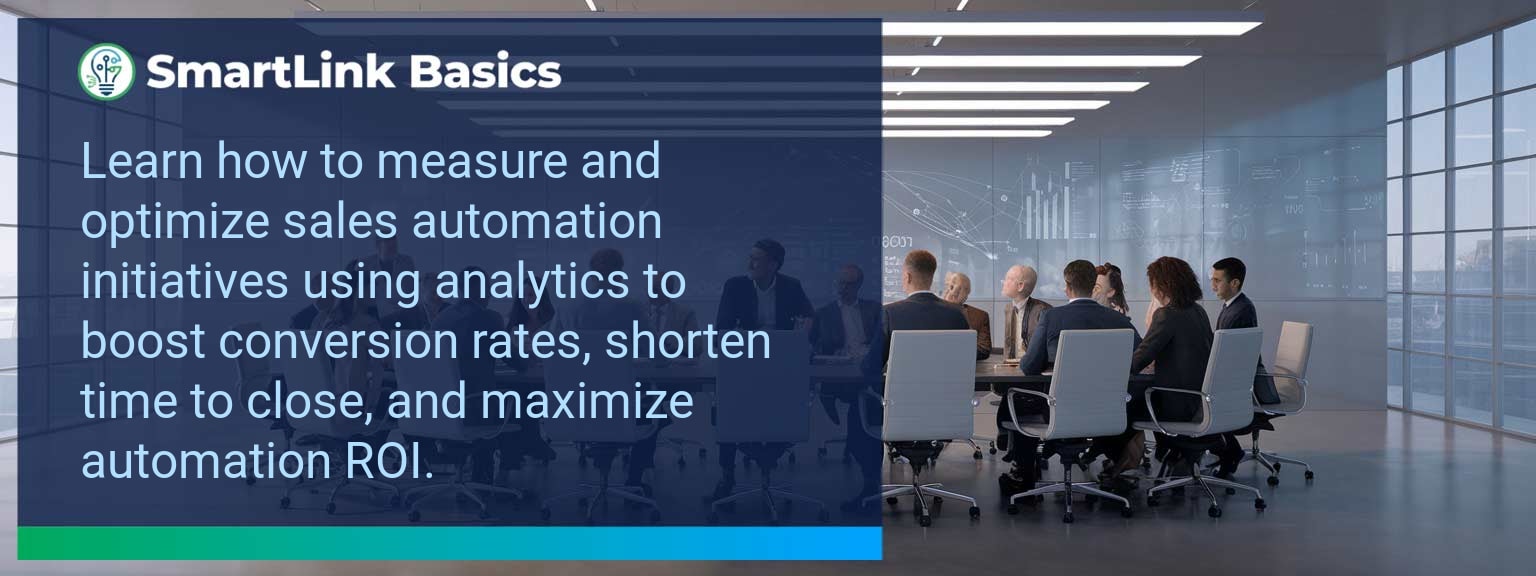Sales leaders who measure what their automation actually does win more predictable revenue. SmartLink Basics helps teams move beyond activity logs to insights that improve close rates and reduce wasted cycle time. This post explains how to use Sales Automation Analytics to prove value, refine plays, and increase automation ROI measurement across the CRM and revenue system. You will get practical metrics, a 90-day plan, and a framework to link automation to pipeline outcomes.
- Define baselines in CRM analytics before rolling out automation.
- Track a balanced set of sales automation metrics across leading, lagging, and quality signals.
- Use controlled pilots to measure automation ROI measurement versus current processes.
- Create feedback loops from reps and customers to catch friction early.
- Operate a 90-day sprint with clear targets and dashboard alarms.
What Changed and Why It Matters Now Sales Automation Analytics
Automation tools now touch every stage of the funnel, from lead scoring to nurture cadences. That creates a data trail in CRMs and engagement platforms that can show which automations move the needle on conversion rate and time to close. Leaders who treat those signals as strategic assets can prioritize plays that lift revenue instead of chasing activity statistics.
When you measure the right things you can attribute results to specific automations and justify further investment in tooling and training.
Redesign the Revenue Operating System With Sales Automation Analytics
Redesigning your revenue operating system requires mapping automation to the buyer journey and measurement plan. Begin with a single segment and instrument the CRM so every automated touch is tagged for analysis. Use automation ROI measurement to decide whether a rule, email cadence, or bot improves conversion rate or just increases noise.
Run a 90-day pilot, compare outcomes to baseline CRM analytics, and apply the learning to other segments.
ICP, Segmentation, and Targeting
Define clear ideal customer profiles and ensure automation logic respects segment priorities. Example: higher-touch segments enter a different play that uses human follow-up after two automated touches. Action: tag leads by ICP and measure segment-level conversion rate.
Pipeline Architecture
Map automation to pipeline stages and track time to close by stage. Example: auto-qualified leads should move to SDR queue within 2 hours; measure compliance and impact on won rates. Action: instrument stage entry timestamps in CRM analytics.
Plays and Messaging
Standardize plays with measurable outcomes. Example: A 5-touch nurture with progressive personalization should be A/B tested. Action: track play completion rate and compare play lift on opportunity creation.
Operating Cadence
Set a governance cadence to review automation performance weekly. Use dashboards that blend leading signals like sequence engagement with lagging results like closed revenue. Action: run a weekly RevOps review to iterate on rules and thresholds.
Common Challenges in Automating Sales Processes
Teams often automate before they measure. That leads to inflated activity metrics without corresponding pipeline lift. Another common issue is poor data hygiene: duplicate records or wrong lead scoring masks true impact. A quick audit of CRM analytics and lead scoring will surface most problems.
Practical fix: freeze major automation changes, clean the baseline data, then restart with a controlled test.
Analytics-Driven Frameworks To Assess Automation
Use an analytics framework that pairs leading indicators with lagging outcomes. Track touches, sequence engagement, and lead scoring changes as leading metrics. Compare those to lagging measures such as pipeline creation, win rate, and revenue per deal. Use cohort analysis to isolate the effect of automation versus seasonal or product changes.
Example: a company used segmented cohort tracking to show that a new routing automation reduced average time to first contact by 40%, which increased opportunity creation by 18% in the target cohort.
Interpreting Results and Key Performance Indicators
Focus on KPIs that connect behavior to outcome. Check conversion rate changes at each funnel stage, monitor time to close, and validate lead scoring shifts against win probability. Good analytics separate noise—like high email-open counts—from signals that correlate with revenue.
Actionable step: set dashboard alerts for a decline in stage conversion rate or a jump in automated disqualifications so you can act quickly.
Table description: The table below lists Leading, Lagging, and Quality metrics you can track today to measure automation effectiveness and align performance to outcomes.
| Category | Metric | Definition | Target |
|---|---|---|---|
| Leading | Sequence Engagement Rate | % of leads who open or reply in first 7 days of sequence | 20%+ |
| Leading | Lead Scoring Movement | % of leads that increase score after automation touch | 15%+ |
| Lagging | Pipeline Conversion Rate | % of automated-sourced leads that become opportunities | 5%+ |
| Lagging | Time To Close | Median days from opportunity creation to won | Reduce 15% YoY |
| Quality | Deal Quality Score | Qualitative rating of deal fit after automation qualification | 80%+ good fit |
| Quality | Rep Satisfaction With Automation | Surveyed alignment and trust in automation decisions | 70%+ positive |
Get the 90-day plan, coaching rubric, and dashboard template to operationalize AI in your enablement program.
Scaling Automation With Continuous Improvement
Scale automation by codifying what works and stopping what does not. Use A/B tests, cohort comparisons, and controlled rollouts to prevent false positives. Pair quantitative signals from CRM analytics with qualitative feedback from reps to refine flows and messaging.
Example action: expand a pilot only when pipeline conversion and deal quality both improve and rep satisfaction is above the threshold.
Measure Automation Effectiveness And Scale Revenue Leadership
Sales automation becomes an engine only when it is measured and iterated. This post outlined baselines, sales automation metrics, CRM analytics approaches, and a testing roadmap to tie automation to revenue. Use the 90-day plan, the metrics table, and weekly reviews to convert insight into action. For tools, templates, and deeper playbooks visit AI-driven sales enablement resources from SmartLink Basics.








